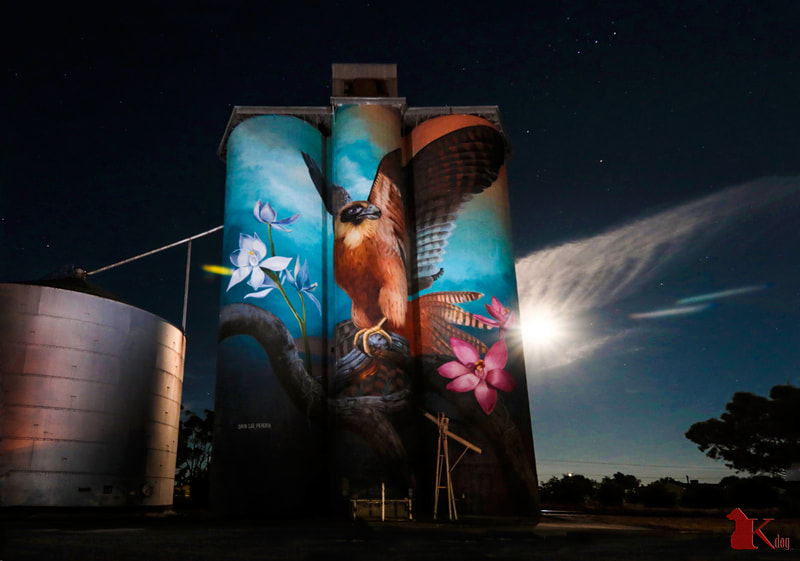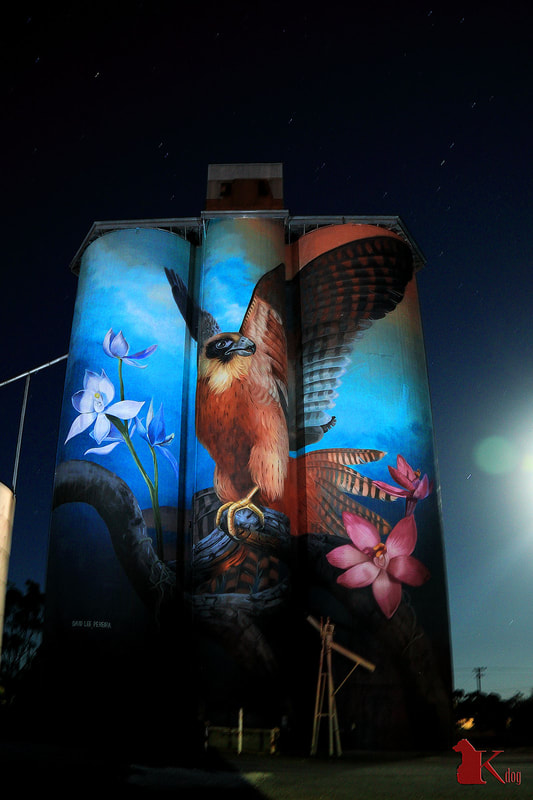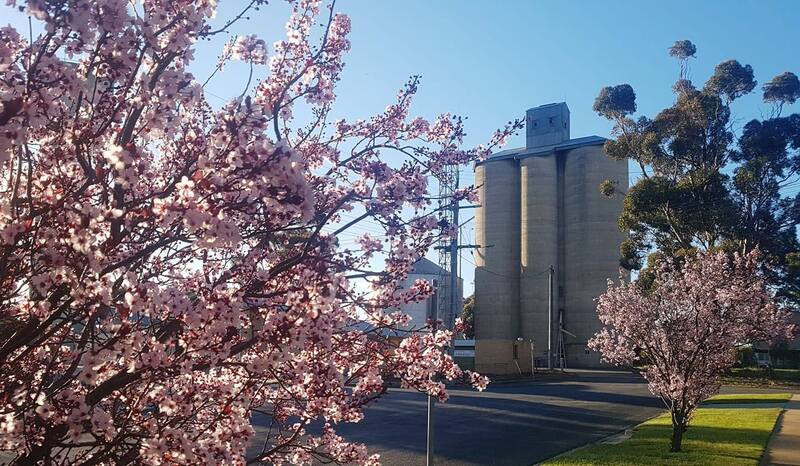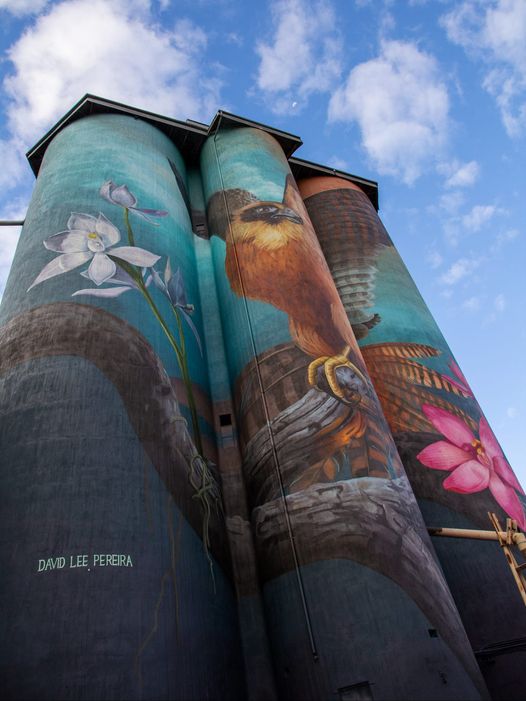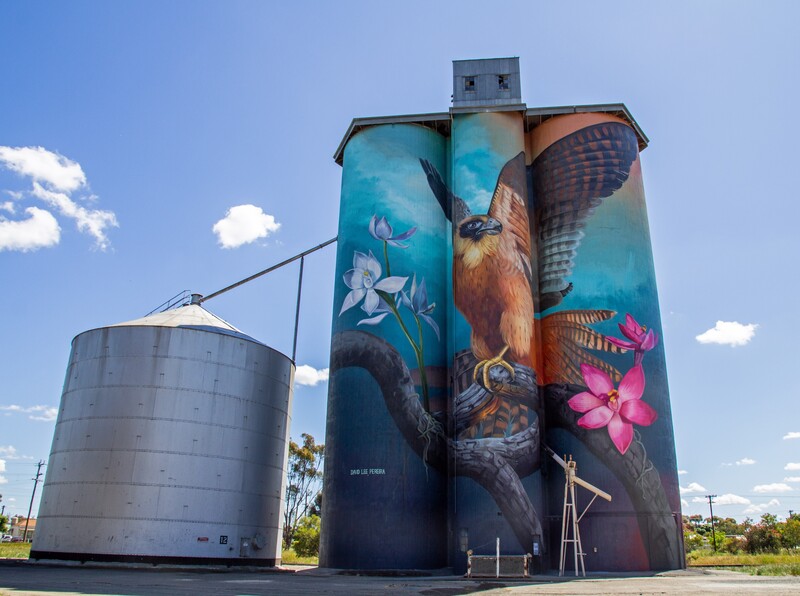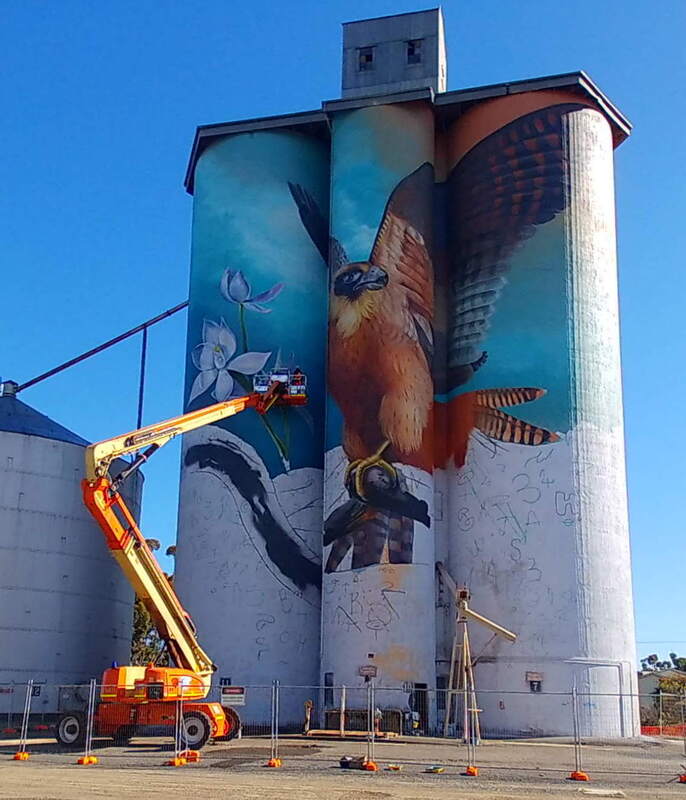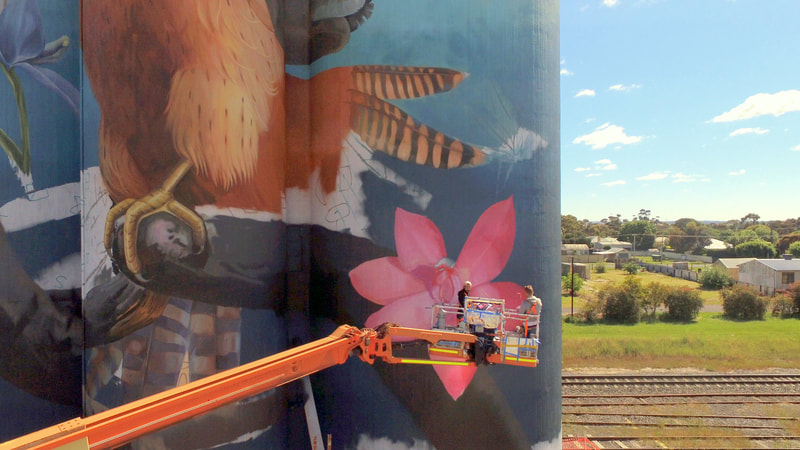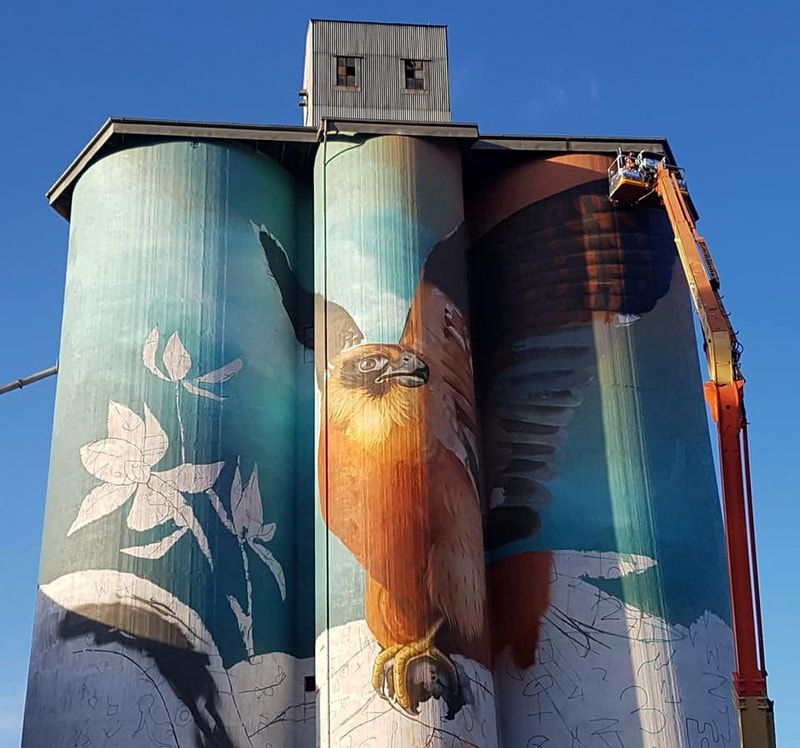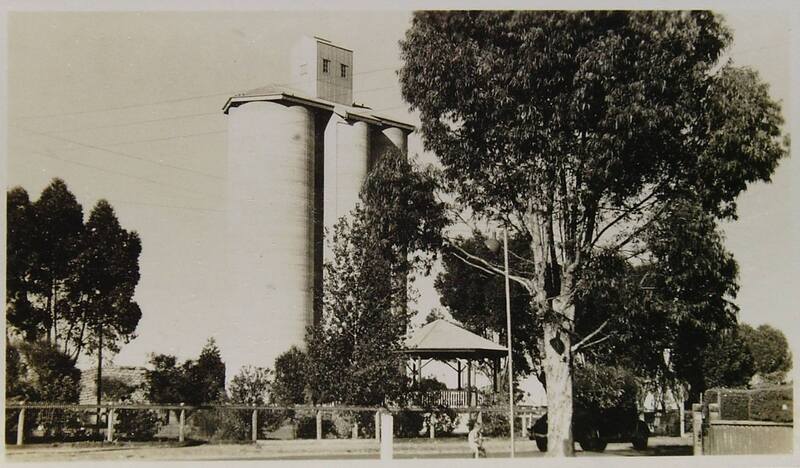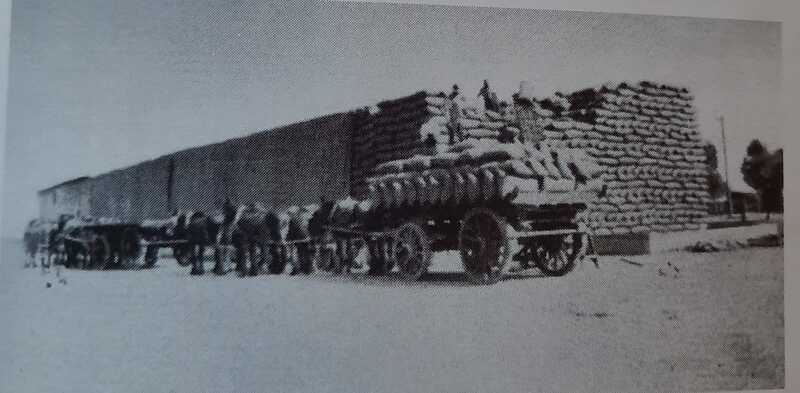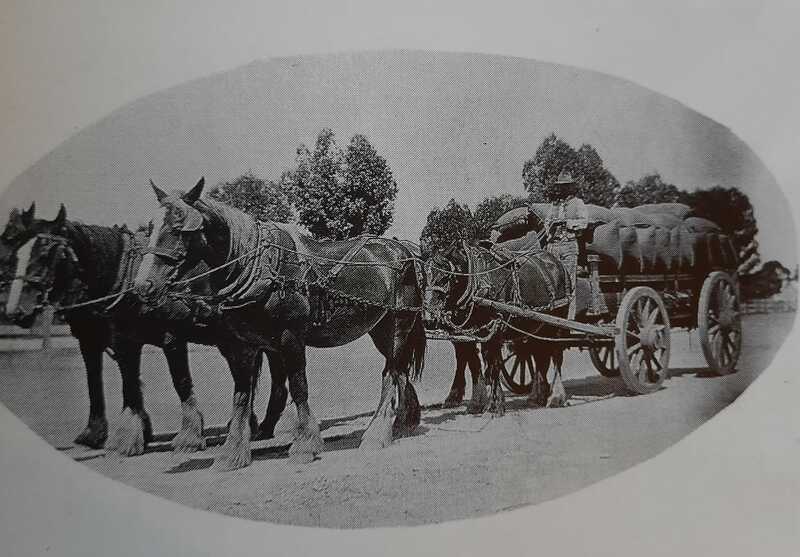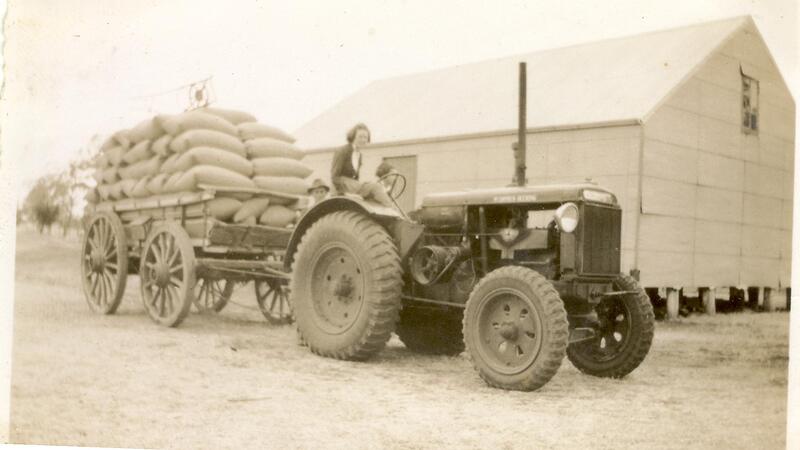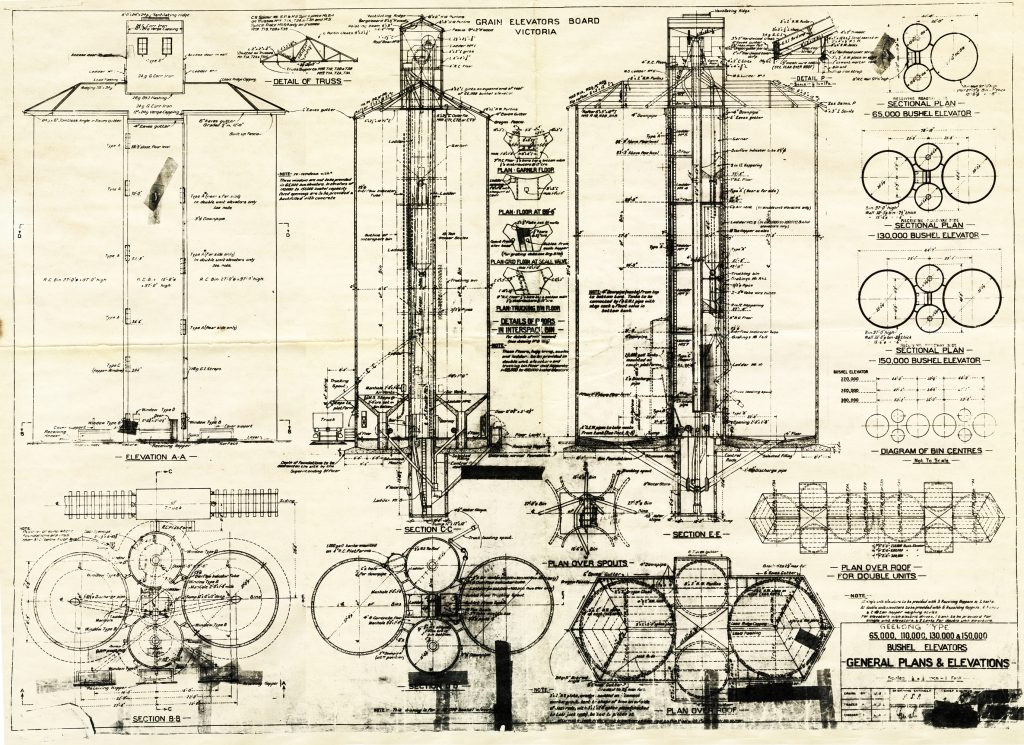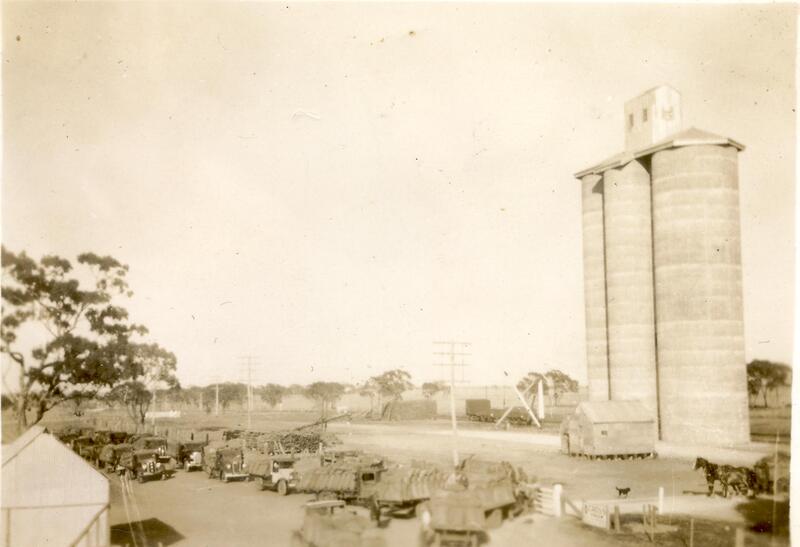Kaniva Silo Art
Welcome to the Kaniva, the Western gateway to the Wimmera Mallee Silo Art Trail in Victoria! The Kaniva GrainCorp Silos are situated near the Band Park, a lovely picnic spot complete with a children's play area next to the war memorial.
Location & Amenities
While visiting, please be mindful of trucks accessing the site during harvest and out-loading seasons, along with emergency vehicle access at the nearby fire station. We recommend parking alongside the Band Park or in the designated car park on Progress St and Baker St near the Senior Citizens.
The silo art viewing area includes brand new accessible facilities including picnic table with shade and public toilets, plus accessible footpath. Access to the site is facilitated by a small pedestrian gate near the toilets. After viewing the Silo Art, follow the Sheep Art Trail to the main street and the Wetlands and Fauna Park.
Photographic tips
Capture the beauty of the GrainCorp Silo Art with the best lighting before mid-morning or after late afternoon. The best viewing point for the Silo is from the left hand side near the toilets, use the large tree to frame the shot and bring your subject close to you.
Artistic Tribute to Little Desert National Park
The artwork celebrates the nearby Little Desert National Park and its diverse flora and fauna. The Little Desert National Park stretches from the Victorian Border to Dimboola. It rates high in botanical significance and, in late spring after good rains, features wildflowers and some orchids. The Little Desert derives its name from the mostly sandy soils that are unsuitable for farming (and the fact that it is ‘little’ compared with the Big Desert to the north of Kaniva). The Little Desert National Park is home to more than 600 species of native plants, 220 species of birds and 60 native mammals and reptiles. The Little Desert dispute of 1968 was a watershed in Australian environmental politics, marking the beginning of conservation and a new consciousness of nature. Local farmer and botanist Alec Hicks, along with local farmers P.L. Williams and Avelyn Coutts (known locally as the three blind mice) were instrumental in this battle, with P.L. Williams donating the land at Broughton's Waterhole, to ensure its ongoing protection. Thanks to their efforts, Broughton's Waterhole is a popular bush camping spot and makes for a pleasant 4WD drive day trip in the bush, exploring Mt Turner, Sister Hills and nearby Yanipy Nature Reserve.
The Artwork
The design features the Australian Hobby bird. Smaller than other falcons, it is one of six Australian members of the family ‘Falconidae’. The Australian Hobby is relatively slender and long-winged. It is often seen hunting in vegetated urban areas, as well as in almost any lightly timbered country. To the left of the bird is the scented sun orchid (Thelymitra megacalyptra) with the salmon sun orchid (Thelymitra rubra) on the right. Flowering occurs between September and November, and they generally only open on warm, humid days.
The Artist
David Lee Pereira is a Melbourne-based studio and mural artist. He was assisted by fellow artist and friend Jason Parker. Local photographer Cindy McDonald provided the reference images that David chose for the silo. “We painted for over 200 hours straight, through the elements and the cockatoo attacks and rain, painting with 400 litres of paint to create this tribute to the Little Desert. I wanted to respect native Australia, we need to be reminded to cherish and save it" said David. The Kaniva GrainCorp Silo was completed in October 2020. David also painted the GrainCorp Silos in Merriwa NSW.
Kaniva Grain Silos
Before the advent of silos, bagged wheat was loaded directly into rail wagons. When wagons were unable to keep up with grain production, bags were stacked and stored in the railway yards, but there were large losses of grain due to wet weather, rodents and insect infestation. The losses prompted a silo building program along existing railway lines. In 1934 legislation authorised the establishment of the Victorian Grain Elevators Board, now known as GrainCorp. The Kaniva Silo is known as a Geelong Concrete Silo and stands 29.6mt high. Overall 91 silos were built in Victoria between 1935 and 1950 using this design. These units are open-topped bins with corrugated galvanised iron roofs. Receiving and out-loading rates are a nominal 110 tonnes per hour. Construction on the Kaniva silo began in January 1939 and it was completed in November that same year. It had a capacity of taking 2,950 tonnes and received 4,979 tonnes of wheat in the 1939-40 harvest. The silo was in use until 2014. The GrainCorp Receival Centre is now located at Lillimur which has the capacity to handle 120,000 tonnes.
The Goroke Silo located in Goroke meaning magpie, features the magpie, kookaburra and galah. The artwork by renowned bird artist Geoffrey Carran, includes a dopper fence, translucent sky, running emus in the distance, and incredible detail including smaller paintings within the birds eye.
The Serviceton Silo is also due to be painted as part of this same project, it is still experiencing delays we will update this page once we have a rough date.
Silo Art History
The first silo was painted in 2015 in Northam WA. In January 2016, nine months after its completion, Brim in the Wimmera Mallee was painted by world renowned Australian artist Guido van Helten. What started as a small community project on a limited budget by the Brim Active Community Group, resulted in widespread international media attention and an influx of visitors to the region. The Silo Art Trail quickly followed as a partnership between GrainCorp, Juddy Roller and Yarriambiack Shire Council. In 2017, KDPA registered interest in Silo Art after Victorian Premier Dan Andrews and Wimmera Mallee Tourism announced a further $500,000 for additional silo art. The concept was to bring much needed tourism dollars into tiny towns in the Wimmera Mallee region with populations under 1,000. Although our request was unsuccessful, KDPA then applied through the 2018 Vic government pilot program, Pick My Project. This involved running a social media campaign to attract public votes. The submission was only just successful, receiving 180 votes. WWSC received $198K in February 2019 with thanks to the Victorian Government for Kaniva and Serviceton Silo Art. The project was then taken over by project partner WWSC. After numerous delays, the silo was painted in 2020. The designated parking area and interpretive signage, with new toilets are soon to be installed.
Maps and Resources
Expand your Silo Art Trail adventure with the help of free smartphone walking tours, podcasts, and downloadable maps. Embark on a rural journey along the 600 km long Wimmera Mallee Silo Art Trail, allowing 3-4 days to see it all.
Welcome to the Kaniva, the Western gateway to the Wimmera Mallee Silo Art Trail in Victoria! The Kaniva GrainCorp Silos are situated near the Band Park, a lovely picnic spot complete with a children's play area next to the war memorial.
Location & Amenities
While visiting, please be mindful of trucks accessing the site during harvest and out-loading seasons, along with emergency vehicle access at the nearby fire station. We recommend parking alongside the Band Park or in the designated car park on Progress St and Baker St near the Senior Citizens.
The silo art viewing area includes brand new accessible facilities including picnic table with shade and public toilets, plus accessible footpath. Access to the site is facilitated by a small pedestrian gate near the toilets. After viewing the Silo Art, follow the Sheep Art Trail to the main street and the Wetlands and Fauna Park.
Photographic tips
Capture the beauty of the GrainCorp Silo Art with the best lighting before mid-morning or after late afternoon. The best viewing point for the Silo is from the left hand side near the toilets, use the large tree to frame the shot and bring your subject close to you.
Artistic Tribute to Little Desert National Park
The artwork celebrates the nearby Little Desert National Park and its diverse flora and fauna. The Little Desert National Park stretches from the Victorian Border to Dimboola. It rates high in botanical significance and, in late spring after good rains, features wildflowers and some orchids. The Little Desert derives its name from the mostly sandy soils that are unsuitable for farming (and the fact that it is ‘little’ compared with the Big Desert to the north of Kaniva). The Little Desert National Park is home to more than 600 species of native plants, 220 species of birds and 60 native mammals and reptiles. The Little Desert dispute of 1968 was a watershed in Australian environmental politics, marking the beginning of conservation and a new consciousness of nature. Local farmer and botanist Alec Hicks, along with local farmers P.L. Williams and Avelyn Coutts (known locally as the three blind mice) were instrumental in this battle, with P.L. Williams donating the land at Broughton's Waterhole, to ensure its ongoing protection. Thanks to their efforts, Broughton's Waterhole is a popular bush camping spot and makes for a pleasant 4WD drive day trip in the bush, exploring Mt Turner, Sister Hills and nearby Yanipy Nature Reserve.
The Artwork
The design features the Australian Hobby bird. Smaller than other falcons, it is one of six Australian members of the family ‘Falconidae’. The Australian Hobby is relatively slender and long-winged. It is often seen hunting in vegetated urban areas, as well as in almost any lightly timbered country. To the left of the bird is the scented sun orchid (Thelymitra megacalyptra) with the salmon sun orchid (Thelymitra rubra) on the right. Flowering occurs between September and November, and they generally only open on warm, humid days.
The Artist
David Lee Pereira is a Melbourne-based studio and mural artist. He was assisted by fellow artist and friend Jason Parker. Local photographer Cindy McDonald provided the reference images that David chose for the silo. “We painted for over 200 hours straight, through the elements and the cockatoo attacks and rain, painting with 400 litres of paint to create this tribute to the Little Desert. I wanted to respect native Australia, we need to be reminded to cherish and save it" said David. The Kaniva GrainCorp Silo was completed in October 2020. David also painted the GrainCorp Silos in Merriwa NSW.
Kaniva Grain Silos
Before the advent of silos, bagged wheat was loaded directly into rail wagons. When wagons were unable to keep up with grain production, bags were stacked and stored in the railway yards, but there were large losses of grain due to wet weather, rodents and insect infestation. The losses prompted a silo building program along existing railway lines. In 1934 legislation authorised the establishment of the Victorian Grain Elevators Board, now known as GrainCorp. The Kaniva Silo is known as a Geelong Concrete Silo and stands 29.6mt high. Overall 91 silos were built in Victoria between 1935 and 1950 using this design. These units are open-topped bins with corrugated galvanised iron roofs. Receiving and out-loading rates are a nominal 110 tonnes per hour. Construction on the Kaniva silo began in January 1939 and it was completed in November that same year. It had a capacity of taking 2,950 tonnes and received 4,979 tonnes of wheat in the 1939-40 harvest. The silo was in use until 2014. The GrainCorp Receival Centre is now located at Lillimur which has the capacity to handle 120,000 tonnes.
The Goroke Silo located in Goroke meaning magpie, features the magpie, kookaburra and galah. The artwork by renowned bird artist Geoffrey Carran, includes a dopper fence, translucent sky, running emus in the distance, and incredible detail including smaller paintings within the birds eye.
The Serviceton Silo is also due to be painted as part of this same project, it is still experiencing delays we will update this page once we have a rough date.
Silo Art History
The first silo was painted in 2015 in Northam WA. In January 2016, nine months after its completion, Brim in the Wimmera Mallee was painted by world renowned Australian artist Guido van Helten. What started as a small community project on a limited budget by the Brim Active Community Group, resulted in widespread international media attention and an influx of visitors to the region. The Silo Art Trail quickly followed as a partnership between GrainCorp, Juddy Roller and Yarriambiack Shire Council. In 2017, KDPA registered interest in Silo Art after Victorian Premier Dan Andrews and Wimmera Mallee Tourism announced a further $500,000 for additional silo art. The concept was to bring much needed tourism dollars into tiny towns in the Wimmera Mallee region with populations under 1,000. Although our request was unsuccessful, KDPA then applied through the 2018 Vic government pilot program, Pick My Project. This involved running a social media campaign to attract public votes. The submission was only just successful, receiving 180 votes. WWSC received $198K in February 2019 with thanks to the Victorian Government for Kaniva and Serviceton Silo Art. The project was then taken over by project partner WWSC. After numerous delays, the silo was painted in 2020. The designated parking area and interpretive signage, with new toilets are soon to be installed.
Maps and Resources
Expand your Silo Art Trail adventure with the help of free smartphone walking tours, podcasts, and downloadable maps. Embark on a rural journey along the 600 km long Wimmera Mallee Silo Art Trail, allowing 3-4 days to see it all.
- Explore all Kaniva's public artworks with this free smartphone walking tour.
- Listen to the Kaniva podcast featuring the Sheep Art and Silo Art story.
- Travel the Silo Art Trail and download the Story Towns Silo Art Trail podcasts here.
- Download the latest Silo Art Trail map here.
- The Wimmera Mallee Silo Art Trail is around 600 km long. Allow 3 - 4 days.
- Listen back to 'What makes good public art'. Interview featuring Shaun Hossack, creator of the Silo Art Trail.
- Listen to the Little Desert podcasts here.
- Interactive a map of Australian Silo Art
- Read about the impact of Silo Art. Australian Silo Art & Wellbeing
- Explore more things to do and see in Kaniva
A fascinating look at historical footage from 1969. This clip outlines the Australian wheat industry, spanning its history, cultivation, harvesting, bulk handling, processing, research, and marketing. It tracks the industry from its inception to modern innovations in mechanical processes, research, and transportation. It details the seasonal work of farmers and the journey of grain from rural silos to international consumers. Skip to 10:30 for a look at how grain silos worked.
Kaniva, first and last highway town in Victoria.
|
|

